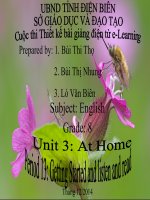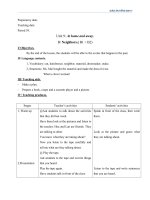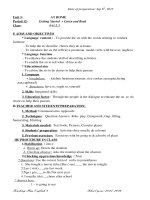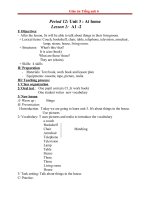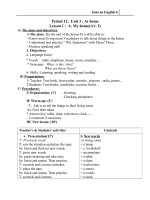Giáo án Tiếng Anh 8 Unit 3: At home
Bạn đang xem bản rút gọn của tài liệu. Xem và tải ngay bản đầy đủ của tài liệu tại đây (184.59 KB, 24 trang )
GIÁO ÁN ENGLISH 8
UNIT 3: AT HOME
LESSON 1: GETTING STARTED - LISTEN AND READ (P. 27, 28)
A. Aim: By the end of the lesson, students will be able to understand the dialogue
between Nam and his mother and use modal verbs to talk about the housework.
B. Methods: Communicative approach
C. Teaching aids:
Teacher: textbook, poster, pictures
Students: textbook, notebook, pens, rulers.
D. Procedure:
I. Class organization: 1 minute
II. Revision: (5 minutes) WARM-UP
III. New lesson:
1. Setting the scene: Included in the WARM-UP
2. Main activities:
Teacher’s and students’ activities
On the board
WARM UP
Kim's game
- T shows 6 pictures (in Getting started) to - Expected answers:
students.
a. Wash dishes/ do the washing up
- T asks them to look at 6 pictures quickly
b. Make the bed
in 30 seconds and try to remember the
verbs in the pictures as many as possible.
c. Sweep the floor
- Then each team goes to the board - one
by one - and writes down the activities in d. Cook
the pictures. The team remembering more
e. Tidy up
verbs is the winner.
PRESENTATION
- T models 3 times then asks Ss to repeat
chorally and individually.
I. Vocabulary
- a rice cooker (picture)
- a steamer: (picture)
- a cup board: (picture)
- a saucepan: (picture)
- a frying pan (picture)
* Checking: What and Where
- T sets the scene: “Nam’s mother – Mrs. II. What Nam has to do?
Vui – is busy and she wants Nam to do
Nam has to
three things for her.”
+ cook dinner
- T gets Ss to listen to the dialogue while
looking at their books and complete the list
+ go to the market to buy fish and
of the things Nam has to do.
vegetables
- T elicits the form by making questions.
- Ss copy down
+ call his aunt, Ms Chi and ask her to
meet his mother at grandma's house
Form:
Has / have to + infinitive = Must +
infinitive
Meaning: Phải (làm gì)
Use: express obligation or necessity
+ Must: authority comes from speaker
+ Have to: authority comes from outside
speaker or laws
Exchange: What do you have to do?
- T models two cues then asks Ss to repeat
chorally then individually.
I must do the washing up
PRACTICE
- T asks Ss to practice asking and
Picture - cued drill
answering in pairs (open pairs – closed
pairs)
1. do the washing up
2. make the bed
3. sweep the floor
4. cook dinner
5. tidy my room
- Ss work in groups of four, discuss the 6. feed the chickens
topic, then representative from each group
FURTHER PRACTICE
states their work.
Group discussion
- Talk about what we have to do and what
we mustn’t do in class: Write in full
sentences
Expected answers:
Have to: keep silent, do homework, learn
last lessons, raise opinion,...
Mustn’t: make noise, be late, fall sleep,
wear jeans ...
IV. Consolidation: (2 minutes)
- T asks students to state the form and use of must and have to
V. Homework
- Write the things you have to do on Sundays.
Ex: On Sundays, I have to tidy my rooms, .... I have to help my parents do the
house work, . ....
- Do exercise 1 & 2
- Prepare SPEAK
UNIT 3: AT HOME
LESSON 2: SPEAK 1 -2 (P. 28, 29)
A. Aim: By the end of the lesson, students will be able to use the prepositions of place to
talk about the positions of furniture in the house.
B. Methods: Communicative approach
C. Teaching aids:
Teacher: textbook, poster, pictures
Students: textbook, notebook, pens, rulers.
D. Procedure:
I. Class organization: 1 minute
II. Revision: (5 minutes) WARM-UP
III. New lesson:
1. Setting the scene: Included in the WARM-UP
2. Main activities:
Teacher’s and students’ activities
On the board
WARM UP
- T divides the class into 2 teams (House Game: What are there in the kitchen?
& Home)
Expected answers:
- T asks both teams – one by one – to go
Stove, sink, bowl, knife, lighting fixture,
to the board and write down as many
refrigerator, table, chair, pan, saucepan,
things in the kitchen as possible within 3
chopstick, cup, glass, plate, spoon, ...
minutes.
- The team which has more correct words
will win the game.
PRESENTATION
I. Vocabulary:
- T elicits words from Ss and models 3 - a rug (picture)
times.
- a lighting fixture (picture)
- a coffee table (picture)
- a counter (picture)
- a calendar (picture)
- a dish rack (picture)
* Checking: Slap the board
II. Questions:
- T shows the picture on page 28 and asks a. Where is the clock?
Ss the positions of the items in the picture:
b. Where is the fruit?
- T gets Ss to work in pairs, talking about
c. Where are the flowers?
the position of each item.
d. Where is the rice cooker?
e. Where is the cupboard?
f. Where are the knives?
g. Where is the dish rack?
* Expected answers:
a. It's above the fridge.
b. in the bowl
c. on the table
d. next to the bowl of fruit
e. on the wall, above the counter.
f. they are on the wall, under the cupboard.
g. on the counter, next to the bowl of fruit.
PRACTICE
- T sets the scene: "Mrs. Vui bought some
new furniture for her living room, but she Ex: The calendar is on the wall, above the
cannot decide where to put it. Please help stove.
her to arrange the furniture"
The knives are on the wall, under the
- T asks Ss to look at the picture on page cupboard.
29 and talk about their ideas.
FURTHER PRACTICE
- T asks Ss to practice speaking using the
expressions.
USEFUL EXPRESSIONS:
Agreeing
- Ss work in pairs, try to use expressions
to make a meaning and logical dialogue.
OK.
- T calls some pairs to demonstrate.
You're right
Disagreeing
No, I think we'd
better / ought to
put ...
I think it should
be ...
- Expected answers:
+ Let's put the clock on the wall, between
the shelf and the picture.
+ OK. I think we ought to put the TV and
the stereo on the shelf.
+ I think the coffee table should be between
the couch and the armchair.
+ Let's put the telephone next to the couch.
+ I think we should put the magazine above
the books on the shelves.
+ I think the shelves ought to be at one of
the corners, opposite the couch.
IV. Consolidation: (2 minutes)
- T asks students to state the main expressions in talking about the positions of things.
V. Homework
- Prepare the next part of the lesson: Listen and Language Focus 3
UNIT 3: AT HOME
LESSON 3: LISTEN & LANGUAGE FOCUS 3 (P. 30, 35, 36)
A. Aim: By the end of the lesson, students will be able to identify the right item by
listening and use reflexive pronouns.
B. Methods: Communicative approach
C. Teaching aids:
Teacher: textbook, poster, pictures
Students: textbook, notebook, pens, rulers.
D. Procedure:
I. Class organization: 1 minute
II. Revision: (5 minutes) WARM-UP
III. New lesson:
1. Setting the scene: Included in the WARM-UP
2. Main activities:
Teacher’s and students’ activities
On the board
WARM UP
- T divides Ss into 2 groups and asks Who are quicker?
each group to write down the food we
Expected answer: meat, chicken, soup, garlic,
eat.
onion, rice, noodles, cabbages, green pepper,
- Ss write down and T checks
etc.
PRE-LISTENING
1. Vocabulary:
- green pepper (n) (picture)
- T elicits each word and models - ham (n) (realia)
thrice.
- garlic (n) (realia)
- Ss copy down
- a repairman (explanation = a person whose job
is to repair things)
- (to) try (translation)
- (to) kill (explanation
somebody/something die)
=
to
make
* Checking: what and where
2. Prediction:
a.
- T gets Ss to look at P. 30 and guess 4
b.
things they use to cook the "Special
Chinese Fried Rice"
c.
d.
WHILE LISTENING
- Expected answers:
- T has Ss listen to the tape twice or a. fried rice, b. pan, c. garlic and green peppers,
thrice and checks their prediction.
d. ham and peas.
PRESENTATION
REFLEXIVE PRONOUNS
Form:
I
- T sets the scene: “You do your
homework and no one helps you. What
do you say?'
with
myself
You
yourself / yourselves
She
herself
He
himself
We
ourselves
They
themselves
it
itself
Usage:
- When subject and object of a clause are the
same
- When we want to mean “alone” or “without
- T explains the reflexive Pronouns
help”, to emphasize ‘that person, nobody else’
and their usage, giving examples.
- We do not use reflexive pronoun with “feel,
relax, concentrate” or actions which people
usually do to themselves (e.g. wash, shave,
dress)
Ex: She cut herself.
- Ss copy down
I build the house myself.
PRACTICE
Model sentence:
- T models two cues then asks Ss to
repeat chorally then individually.
Ex: 1. Did you do your homework?
Yes, I did it myself.
Did you do your homework?
Yes. I did it myself.
Word cued drill
1. you / do / homework
- T asks Ss to practice asking and 2. He / fix / washing machine
answering.
3. Mary / cook / dinner
- Open pairs – closed pairs
4. These students / paint / the pictures
5. You / do / your chores
FURTHER PRACTICE
Complete the dialogue
- Expected answers:
a. Did someone help Ba to draw that picture? - T asks Ss to fill in the blanks with No. He did it himself.
suitable
reflexive
emphasis pronouns.
pronouns
- T gives feedback
or b. The repair man can’t fix the washing machine
until tomorrow. - Come on. We'll have to try
and do it ourselves.
c. What's the matter, Hoa?
- T asks Ss to practice speaking in
pairs.
- I cut myself.
Let me see. Oh, it's all right. You didn't cut
yourself badly.
d. Why are you crying, Nga?
- I have just watched the movies Romeo and
Juliet. The boy killed himself and then the girl
killed herself as well.
Why did they kill themselves?
- It's a long story.
e. Boys and girls, you'll do the experiment this
afternoon.
- Will you come to help us?
Yes, I will. But you have to do it yourselves
first.
IV. Consolidation: (2 minutes)
- T asks students to state the main usage of Reflexive pronouns.
V. Homework
- Prepare the next part of the lesson: Read
- Do exercise 3, 4 in workbook
UNIT 3: AT HOME
LESSON 4: READ 1 -2 (P. 31, 32)
A. Aim: By the end of the lesson, students will be able to understand the safety
precautions in the house and use Why - Because.
B. Methods: Communicative approach
C. Teaching aids:
Teacher: textbook, poster, pictures, realia
Students: textbook, notebook, pens, rulers.
D. Procedure:
I. Class organization: 1 minute
II. Revision: (5 minutes) WARM-UP
III. New lesson:
1. Setting the scene: Included in the WARM-UP
2. Main activities:
Teacher’s and students’ activities
On the board
WARM UP
- T divides Ss into 2 groups and asks Brainstorming:
each group to come to the board
and
Electricity
write the things that cause danger for
children
Drug in the home.
Dangers
- Ss play in group
andin the
take turns to Knife
home for children
write down the words.
Boiling
water
Fire
Gas
- T models 3 times and gets Ss to
repeat
PRE - READING
I. Pre - teach vocabulary:
- a precaution (translation)
- a socket (realia)
- a match (realia)
- an object (translation)
- safety (antonym: danger)
- (to) destroy (translation)
- Ss copy down
- (to) injure (picture)
- T divides class into 2 teams to play
- chemical (n) (example: H2SO4, NaCl)
the game “slap the board”
- out of children’s reach (translation)
- T elicits: “There are many dangerous
things in your house. Followings are Checking vocabulary: Slap the board
some advice to make sure safety
II. True - False prediction
precaution”
- T asks Ss to read the statements and 1. It is safe to leave medicine around the house.
guess which are true, which are false.
2. Drugs can look like candy.
3. A kitchen is a suitable place to play.
4. Playing with one match cannot start a fire.
5. Putting a knife into an electrical socket is
dangerous.
6. Young children do not understand that many
household objects are dangerous.
- Ss read the poster and check their
prediction.
- T asks Ss to correct false statements.
WHILE - READING
I. Reading the text
Guess Correct
1.
2.
3.
4.
- T asks Ss review the form and usage
of “Why”.
F It is dangerous to leave medicine
around the house
T
F A kitchen is an unsuitable place to
play
5.
F Playing with one match can start a
fire
6.
T
T
II. Comprehension questions
- T asks Ss to work in pairs to find out
the answers to these questions.
Form:
Why + V(Aux) + S + V + O?
Because + S + V
Usage: to state the reason
1. Why must we put all chemicals and drugs in
a locked cupboard?
2. Why mustn't we let children play in the
kitchen?
3. Why mustn't children play with matches?
4. Why must we cover electrical sockets?
5. Why do we have to put all dangerous objects
out of children's reach?
- T asks Ss to practice asking and - Expected answers:
answering the questions in pairs.
- Open pairs and closed pairs
1. Because children often try to eat and drink
them.
2. Because the kitchen is a dangerous place.
3. Because playing with one match can cause
the fire.
4. Because children often try to put something
- T asks Ss to work in groups of 6, into electrical sockets and electricity can kill.
discussing the topics and write on
5. Because the dangerous objects can injure or
poster. (half of the class discusses the
kill children.
first topic and the rest discusses the
second)
POST - READING
- Two representatives from each group Discussion
present in front of the class.
1. Safety precautions on the street.
- T comments and gives feedback.
2. Safety precautions at school.
IV. Consolidation: (2 minutes)
- T asks students to state the main activities to avoid dangers at home.
V. Homework
- Prepare the next part of the lesson: Write
- Do exercise 5 & 6 in workbook
UNIT 3: AT HOME
LESSON 5: WRITE (P. 32, 33)
A. Aim: By the end of the lesson, students will be able to write a description of a room in
their house.
B. Methods: Communicative approach
C. Teaching aids:
Teacher: textbook, poster, pictures
Students: textbook, notebook, pens, rulers.
D. Procedure:
I. Class organization: 1 minute
II. Revision: (5 minutes) WARM-UP
III. New lesson:
1. Setting the scene: Included in the WARM-UP
2. Main activities:
Teacher’s and students’ activities
On the board
WARM UP
- T divides Ss into 2 groups and asks
each group to write down the things in
their house
- T gives feedback
Things in your house
L
S
A
U
C
E
P
A
I
A
I
K
O
F
E
N
G
R
T
N
O
I
N
U
H
E
A
A
K
N
C
S
T
D
B
T
E
K
H
T
I
L
L
U
R
I
A
O
N
O
E
B
E
D
I
V
G
F
I
X
T
U
R
E
- T asks Ss some information about
the room on p. 32:
+ which room is this?
+ what's this? Where is it?
- T models thrice and gets Ss to repeat.
PRE - WRITING
I. Pre - teach vocabulary
- folder (n) (picture)
- T gets Ss to copy the words into their
- beneath (example)
books and then ask them to close the
books.
- towel rack (n) (picture)
- T rubs out the new words one at a - a wardrobe (n) (picture)
time. Each time T rubs out a word in
English, points to the Vietnamese * Checking vocabulary: ROR
translation and asks "what's this in
English?". When all the English words
are rubbed out, T goes through the
Vietnamese list and gets Ss to call out
II. Reading
the English words.
Questions:
a. What is there on the left of the room?
- T asks Ss to read the description of
Hoa's room, then asks some questions. b. Where is the bookshelf?
c. What is there on the right side of the room?
d. Where is the wardrobe?
- Expected answers:
a. There is a desk on the left of the room.
b. The bookshelf is above the desk.
c. There is a window on the right side of the
room.
d. The wardrobe is beside the window and
opposite the desk.
WHILE - WRITING
- T asks Ss to describe Hoa's kitchen Write the description of Hoa's kitchen, using
in pairs.
the cues.
- Expected answers:
This is Hoa's kitchen.
There is a refrigerator in the right corner of the
room. Next to the refrigerator are the stove and
the oven. On the other side of the oven, there is
a sink and next to the sink is a towel rack. The
dish rack stands on the counter, on the right of
- T asks Ss to share with their partners. the window and beneath the selves. On the
- T corrects the mistakes from some shelves and on the counter beneath the window,
there are jars of sugar, flour and tea. In the
descriptions (if any).
middle of the kitchen, there are a table and four
chairs. The lighting fixture is above the table,
and directly beneath the lighting fixture is a vase
with flowers.
POST - WRITING
- T asks Ss to talk to their partners
Speaking
about their room (bedroom / living
room / kitchen?
Talk to your partner about a room in your house
IV. Consolidation: (2 minutes)
- T asks students to go through the main points used to describe a room.
V. Homework
- Describe a room in your house.
- Prepare the next part of the lesson: Language focus 1, 2, 4
UNIT 3: AT HOME
LESSON 6: LANGUAGE FOCUS 1, 2, 4 (P. 36)
A. Aim: By the end of the lesson, students will be able to use the structure Why –
Because and further practice in modal verb: ought to.
B. Methods: Communicative approach
C. Teaching aids:
Teacher: textbook, poster, pictures, realia
Students: textbook, notebook, pens, rulers.
D. Procedure:
I. Class organization: 1 minute
II. Revision: (5 minutes) WARM-UP
III. New lesson:
1. Setting the scene: Included in the WARM-UP
2. Main activities:
Teacher’s and students’
activities
On the board
WARM UP
- T divides class into 2 teams and Brainstorming
asks Ss to go to the BB and write
Tidy
down things they can/can’t do.
Do our
- Ss of two teams take turn to write
the activities on board.
- T checks.
up
homewor
k
Water
flowers
Things
you can
do
Clean
the floor
Repair the
machine
Fix the
TV set
Things you
can't do
Paint
the
house
PRESENTATION
I. Vocabulary:
- (to) sweep (mime)
- (to) empty (translation)
- (to) dust (mime)
- a fish tank (picture)
- T elicits words from students and - garbage (n) (picture)
gets them to repeat thrice.
* Checking: Slap the board
II. Presenting Modal Verbs:
Form: ought to + infinitive
Usage: to give advice to someone, to express
- T sets the scene: "Hoa is very sad authority coming from outside the speaker (e.g. laws
because she failed her English test. or rules)
What do you say to advise her?".
Meaning: nên
“Can you tell me another word for
"should"”?
Ex: "You should study harder."
- Ss listen to T and answer:
- "ought to"
"You should study harder."
Form: Must/have to + infinitive
- "ought to"
Usage: To express obligation
Meaning: phải
- T asks Ss to review Must & Have
to
PRACTICE
I. Language focus 2:
- Expected answers:
a. I failed my English test.
- You ought to study harder.
- T asks Ss to give advice to
b. I'm late.
people in the pictures (p. 35)
- Ss work in pairs
- You ought to get up earlier.
c. I'm fat.
- You ought to eat more fruit and vegetables.
d. My tooth aches.
- You ought to see a dentist.
II. Language Focus 1:
- Expected answers:
Nga: Can you come to the movies, Lan?
Lan: No, I have to do my chores.
Nga: What do you have to do?
- T gives Ss 7 words: feed - empty
- do - tidy - sweep - clean - dust.
Lan: I must tidy my bedroom. Then I have to dust
the living room and I must sweep the kitchen floor,
- T asks Ss to look at the pictures
too.
and complete the dialogue
between Nga and Lan, using Nga: That won’t take long. What's else?
“Must” or “Have to” together with
Lan: I have to clean the fish tank and then I must
the verbs given.
empty the garbage. Finally, I must feed the dog.
- Ss work in pairs, doing the
exercises then practicing the Nga: OK. Let's start. Then we can go out.
dialogue.
III. Language Focus 4:
- Expected answers:
b. Why did Nam have to cook dinner?
Because his mom went home late
- T gets Ss to do Language Focus c. Why did Nam’s mom go home late?
4 in pairs
Because she visited her mother.
- T gives feedback
d. Why did Ha fail her English test?
- Open pairs – Closed pairs
Because she played video games all day.
e. Why couldn’t Nga go to the movies?
Because she had to do the housework
PRODUCTION
Noughts and Crosses:
- T divides the class into 2 teams
and has them play the game:
noughts and crosses.
His tooth /
ache
Hoa / late
My room / untidy
The floor /
dirty
Bao /
overweight
She / thin
My English /
bad
Her grades /
bad
The washing
machine / not
work
- Expected answers:
a. His tooth aches
+ He ought to go to the dentist.
b. Hoa is late.
+ She ought to get up earlier.
c. My room is untidy.
+ You ought to tidy your room.
d. The floor is dirty.
+ You ought to clean it.
e. Bao is overweight.
+ He ought to eat less meat and do
exercise more often.
f. She is thin.
+ She ought to eat more.
g. My English is bad.
+ You ought to practice more.
h. Her grades are bad.
+ She ought to study harder.
i. The washing machine doesn't
work.
+ You ought to fix it.
IV. Consolidation: (2 minutes)
- T asks students to give some examples of reflexive pronouns
V. Homework
- Do exercise 7 & 8 in workbook
- Review unit 1, 2, 3 for test

